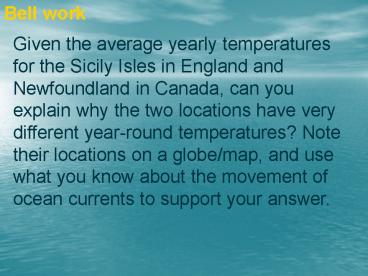Ocean Currents - PowerPoint PPT Presentation
1 / 38
Title: Ocean Currents
1
Bell work
Given the average yearly temperatures for the
Sicily Isles in England and Newfoundland in
Canada, can you explain why the two locations
have very different year-round temperatures? Note
their locations on a globe/map, and use what you
know about the movement of ocean currents to
support your answer.
2
Objectives for today!
- Describe surface currents.
- List the three factors that control surface
currents. - Describe deep currents.
- Identify the three factors that form deep
currents. - Investigate the relationship between currents
and oceanic temperature differences. - Explain how currents affect climate.
- Describe the effects of El Niño.
3
Ocean Currents
4
What is a current?
- A current is the movement of water that follows a
regular pattern. - Ocean water contains streamlike movements of
water called ocean currents. - There are two types of currents, surface currents
and deep currents.
5
Surface currents
- There are three causes of surface currents.
- Continental deflection
- Global winds
- Coriolis Effect
6
What do you think continental deflection is?
7
Continental deflection
- If the Earth was made up of only water, than the
oceans would move in a uniform pattern. - However the continents cause the currents to
change directions when the current meets land.
8
How do you think winds control currents?
9
Global winds
- This is where the winds above the oceans surface
push on the water causing it to move.
10
What do you think the Coriolis Effect is?
11
Coriolis effect
- The Coriolis effect is the apparent curving of
the path of a moving object from an otherwise
straight path due to the earths rotation.
12
The Coriolis Effect
Visual Concept
13
All three in action!
- When you combine all three factors they form the
pattern of surface currents on Earth.
14
Surface Currents, continued
- Taking Temperature Currents are also affected
by the temperature of the water in which they
form. - The next slide shows Earths surface currents.
Warm-water currents are shown as red arrows, and
cold-water currents are shown as blue arrows.
15
(No Transcript)
16
(No Transcript)
17
- Warm-water currents begin near the equator and
carry warm water to other parts of the ocean. - Cold-water currents begin closer to the poles and
carry cool water to other parts of the ocean.
18
Objectives for today!
- Describe surface currents.
- List the three factors that control surface
currents. - Describe deep currents.
- Identify the three factors that form deep
currents. - Investigate the relationship between currents
and oceanic temperature differences. - Explain how currents affect climate.
- Describe the effects of El Niño.
19
Deep Currents
- Deep currents are the stream like movements of
water far below the surface of the water. - Density-the amount of matter in a given space
- Salinity- measure of the amount of dissolved
solids or salts in a liquid.
20
Deep Currents
- Deep currents are not controlled by wind.
- Deep currents form in parts of the ocean where
water density increases. The density of the ocean
is affected by temperature and salinity.
21
Deep currents
- There are three ways to increase density of ocean
water - Decrease temperature
- Increase salinity through freezing
- Increase salinity through evaporation
22
Decreasing Temperature
23
Increasing Salinity through Freezing
24
Increasing Salinity through evaporation
25
(No Transcript)
26
Deep Currents, continued
- Formation and Movement of Deep Currents
Differences in water density cause variations in
the movement of deep currents.
27
Objectives for today!
- Describe surface currents.
- List the three factors that control surface
currents. - Describe deep currents.
- Identify the three factors that form deep
currents. - Investigate the relationship between currents
and oceanic temperature differences. - Explain how currents affect climate.
- Describe the effects of El Niño.
28
Ocean Atmosphere Circulation
29
(No Transcript)
30
Equatorial to polar heat transport and water flow
31
How do you think currents affect coastal
tempuratures?
32
Surface Currents and Climate
- Warm-Water Currents and Climate Warm-water
currents create warmer climates in coastal areas
that would otherwise be much cooler. - Why?
33
Surface Currents and Climate, continued
- Cold-Water Currents and Climate Cold-water
currents keep climates along a coast cooler than
the inland climate year-round. - Why?
34
Surface Currents and Climate, continued
- Upwelling is the movement of deep, cold, and
nutrient-rich water to the surface of the ocean. - The nutrients that are brought to the surface
support the growth of plankton. Plankton support
larger organisms, such as fish and seabirds. - Upwelling is shown on the next slide.
35
Upwelling
- This brings nutrient rich waters up to the
surface. - Many organisms depend on these nutrient rich
waters to survive.
36
Surface Currents and Climate, continued
- El Niño is a change in the water temperature in
the Pacific Ocean that produces a warm current. - Effects of El Niño El Niño alters weather
patterns enough to cause disasters, including
flash floods, mudslides, and droughts. El Niño
also prevents upwelling off the coast of South
America.
37
Surface Currents and Climate, continued
- Studying and Predicting El Niño Learning as
much as possible about El Niño is important
because of its effects on organisms and land. - One way scientists use technology to predict an
El Niño is with a network of buoys operated by
the National Oceanic and Atmospheric
Administration (NOAA). - The buoys are located along the Earths equator
record data about surface temperature, air
temperature, currents, and winds.
38
Objectives for today!
- Describe surface currents.
- List the three factors that control surface
currents. - Describe deep currents.
- Identify the three factors that form deep
currents. - Investigate the relationship between currents
and oceanic temperature differences. - Explain how currents affect climate.
- Describe the effects of El Niño.

